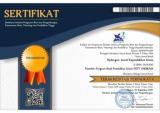Alpha Amylase Inhibitory Activity of Curcumin Analogs and Its Synergy with Ferulic Acid in Vitro
Abstract
Curcumin analog compounds are α,β unsaturated compounds through simplifying the beta diketo group to monoketo, which has better bioavailability and a more stable structure than curcumin compounds. This study aims to determine the α-amylase inhibitory activity on symmetric curcumin analog compounds, namely the compounds 2,6-bis(3,4-dimethoxybenzylidine)cyclohexanone (A) and 2,6-bis(3,4-dimethoxybenzylidine)cyclopentanone (B). as well as testing its synergistic interaction with ferulic acid in vitro. The α-amylase inhibition test was carried out using an iodine reagent and a starch solution as a substrate. The absorbance value was measured using a UV-vis spectrophotometer (λ 568 nm), and the % inhibition was calculated. The average value of the optimum α-amylase inhibition percentage for compounds A, B, and ferulic acid, respectively is 58.17%; 22.95%, and 93.52%. Based on the synergistic interaction, it was concluded that compounds A and B showed synergistic activity with ferulic acid. The percentage of α-amylase inhibition in the concentration ratio of curcumin analog A: ferulic acid (1:8) was 98.65%, and curcumin analog B: ferulic acid (1:4) was 98.37%. This shows that combining compounds between symmetrical curcumin analogs and ferulic acid can increase the activity of antidiabetic drug candidate compounds compared to single compounds. This study offers a new approach by testing the potential combination of curcumin and ferulic acid analogues as α-amylase inhibitors in vitro, demonstrating a synergy that has not been widely explored and opening up opportunities for developing more effective natural antidiabetic therapies.
Keywords
Full Text:
PDFReferences
Adisakwattana, S., Chantarasinlapin, P., Thammarat, H., & Anun, S. Y. (2009). A Series of Cinnamic Acid Derivatives and Their Inhibitory Activity on Intestinal Alpha-Glucosidase. J Enzyme Inhib Med Chem, 24(5), 1194–1200. https://doi.org/10.1080/14756360902779326
Annapurna, H. V, Apoorva, B., Ravichandran, N., Arun, K. P., Brindha, P., Swaminathan, S., Vijayalakshmi, M., & Nagarajan, A. (2013). Isolation and in silico evaluation of antidiabetic molecules of Cynodon dactylon (L.). J Mol Graph Model, 39, 87–97. https://doi.org/10.1016/j.jmgm.2012.10.009
Anonymous. (2021). IDF Diabetes Atlas (10th ed.). International Diabetes Federation. www.diabetesatlas.org
Arya, A., Jamil Al-Obaidi, M. M., Shahid, N., Bin Noordin, M. I., Looi, C. Y., Wong, W. F., Khaing, S. L., & Mustafa, M. R. (2014). Synergistic effect of quercetin and quinic acid by alleviating structural degeneration in the liver, kidney and pancreas tissues of STZ-induced diabetic rats: A mechanistic study. Food and Chemical Toxicology, 71, 183–196. https://doi.org/10.1016/j.fct.2014.06.010
Bhosale, H. J., Mamdapure, S. V., Panchal, R. B., & Dhuldhaj, U. P. (2024). α-Amylase, α-glucosidase and aldose reductase inhibitory and molecular docking studies on Tinospora cordifolia (Guduchi) leaf extract. Future Journal of Pharmaceutical Sciences, 10(1). https://doi.org/10.1186/s43094-024-00671-9
Ghosh, S., Banerjee, S., & Sil, P. C. (2015). The beneficial role of curcumin on inflammation, diabetes and neurodegenerative disease: A recent update. Food Chem Toxicol, 83, 111–124. https://doi.org/10.1016/j.fct.2015.05.022
Gupta, R. C., Chang, D., Nammi, S., Bensoussan, A., Bilinski, K., & Roufogalis, B. D. (2017). Interactions between antidiabetic drugs and herbs: An overview of mechanisms of action and clinical implications. Diabetology and Metabolic Syndrome, 9(1), 1–12. https://doi.org/10.1186/s13098-017-0254-9
Jung, E. H., Kim, S. R., Hwang, I. K., & Ha, T. Y. (2007). Hypoglycemic effects of a phenolic acid fraction of rice bran and ferulic acid in C57BL/KsJ-db/db mice. J Agric Food Chem, 55(24), 9800–9804. https://doi.org/10.1021/jf0714463
Kumar, N., & Pruthi, V. (2014). Potential applications of ferulic acid from natural sources. biotechnology reports, 4, 86–93. https://doi.org/10.1016/j.btre.2014.09.002
Nampoothiri, S. V, Prathapan, A., Cherian, O. L., Raghu, K. G., Venugopalan, V., & Sundaresan, A. (2011). In vitro antioxidant and inhibitory potential of Terminalia bellerica and Emblica officinalis fruits against LDL oxidation and key enzymes linked to type 2 diabetes. Food Chem Toxicol, 49(1), 125–131. https://doi.org/10.1016/j.fct.2010.10.006
Ngili, Y. (2013). Biokimia Dasar. Rekayasa Sains.
Ponnusamy, S., Zinjarde, S., Bhargava, S., Rajamohanan, P., & Ravikumar, A. (2012). Discovering Bisdemethoxycurcumin from Curcuma longa rhizome as a potent small molecule inhibitor of human pancreatic α-amylase, a target for type-2 diabetes. Food Chem, 135(4), 2638–2642. https://doi.org/10.1016/j.foodchem.2012.06.110
Prabhakar, P. K., Prasad, R., Ali, S., & Doble, M. (2013). Synergistic interaction of ferulic acid with commercial hypoglycemic drugs in streptozotocin induced diabetic rats. Phytomedicine, 20(6), 488–494. https://doi.org/10.1016/j.phymed.2012.12.004
Putri, I. . (2016). Sintesis Senyawa Analog Kurkumin dari Bahan Dasar Veratraldehida dan Bromoveratraldehida, dan Uji Inhibisinya terhadap Enzim α-Glukosidase. Gadjah Mada University Yogyakarta.
Sakač, N., Karnaš, M., Dobša, J., Jozanović, M., Gvozdić, V., Kovač-Andrić, E., Sakač, M. K., & Šarkanj, B. (2020). Application of spectrophotometric fingerprint in cluster analysis for starch origin determination. Food Technology and Biotechnology, 58(1), 5–11.
Santoso, M., Ong, L. L., Aijijiyah, N. P., Wati, F. A., Azminah, A., Annuur, R. M., Fadlan, A., & Judeh, Z. M. A. (2022). Synthesis, α-glucosidase inhibition, α-amylase inhibition, and molecular docking studies of 3,3-di(indolyl)indolin-2-ones. Heliyon, 8(3), e09045. https://doi.org/10.1016/j.heliyon.2022.e09045
Tallarida, R. . (2001). Drug Synergism: Its Detection and Applications. J. Pharmacol. Exp. Therapeut, 298(3), 865–872.
Wang, X., Yang, J., Li, H., Shi, S., & Peng, X. (2022). Mechanistic study and synergistic effect on inhibition of α-amylase by structurally similar flavonoids. Journal of Molecular Liquids, 360. https://doi.org/10.1016/j.molliq.2022.119485
Xiao, Z., Storms, R., & Tsang, A. (2006). A quantitative starch-iodine method for measuring alpha-amylase and glucoamylase activities. Anal Biochem, 351(1), 144–148. https://doi.org/10.1016/j.ab.2006.01.036
DOI: https://doi.org/10.33394/hjkk.v13i3.15683
Refbacks
- There are currently no refbacks.

This work is licensed under a Creative Commons Attribution-ShareAlike 4.0 International License.





